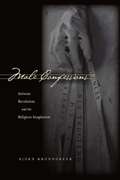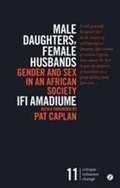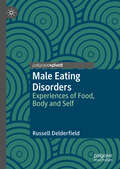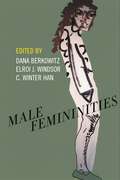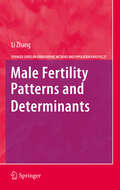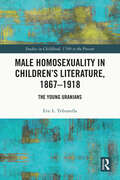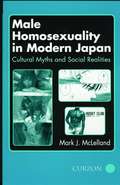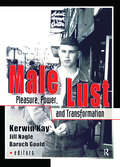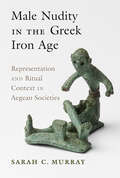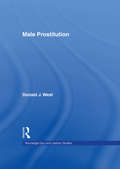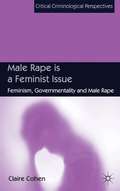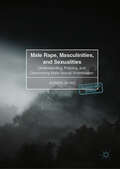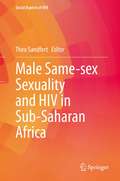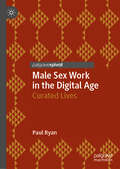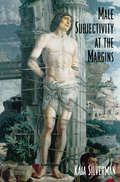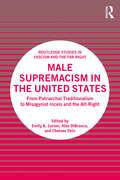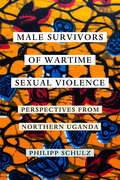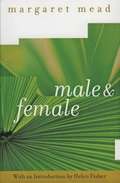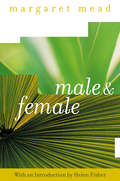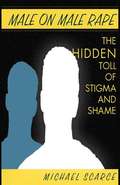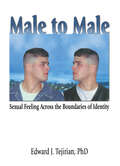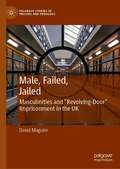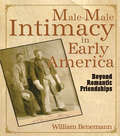- Table View
- List View
Male Confessions: Intimate Revelations and the Religious Imagination
by Björn KrondorferMale Confessions examines how men open their intimate lives and thoughts to the public through confessional writing. This book examines writings--by St. Augustine, a Jewish ghetto policeman, an imprisoned Nazi perpetrator, and a gay American theologian--that reflect sincere attempts at introspective and retrospective self-investigation, often triggered by some wounding or rupture and followed by a transformative experience. Krondorfer takes seriously the vulnerability exposed in male self-disclosure while offering a critique of the religious and gendered rhetoric employed in such discourse. The religious imagination, he argues, allows men to talk about their intimate, flawed, and sinful selves without having to condemn themselves or to fear self-erasure. Herein lies the greatest promise of these confessions: by baring their souls to judgment, these writers may also transcend their self-imprisonment.
Male Daughters, Female Husbands: Gender and Sex in an African Society
by Ifi AmadiumeIn 1987, more than a decade before the dawn of queer theory, Ifi Amadiume wrote Male Daughters, Female Husbands, to critical acclaim. This compelling and highly original book frees the subject position of 'husband' from its affiliation with men, and goes on to do the same for other masculine attributes, dislocating sex, gender and sexual orientation. <P><P>Boldly arguing that the notion of gender, as constructed in Western feminist discourse, did not exist in Africa before the colonial imposition of a dichotomous understanding of sexual difference, Male Daughters, Female Husbands examines the structures in African society that enabled people to achieve power, showing that roles were not rigidly masculinized nor feminized. At a time when gender and queer theory are viewed by some as being stuck in an identity-politics rut, this outstanding study not only warns against the danger of projecting a very specific, Western notion of difference onto other cultures, but calls us to question the very concept of gender itself.
Male Eating Disorders: Experiences of Food, Body and Self
by Russell DelderfieldThis book takes a novel approach to the study of male eating disorders – an area that is often dominated by clinical discourses. The study of eating disorders in men has purportedly suffered from a lack of dedicated attention to personal and socio-cultural aspects. Delderfield tackles this deficiency by spotlighting a set of personal accounts written by a group of men who have experiences of disordered eating. The text presents critical interpretations that aim to situate these experiences in the social and cultural context in which these disorders occur. This discursive work is underpinned by an eclectic scholarly engagement with social psychology and sociology literature around masculinities, embodiment and fatness, belonging, punishment, stigma, and control; leading to understandings about relationships with food, body and self. This is undertaken with a reflexive element, as the personal intersects with the professional. This text will appeal to students, scholars and clinicians in social sciences, humanities, and healthcare studies, including public health.
Male Femininities
by C. Winter Han Dana Berkowitz Elroi J. WindsorInnovative essays that explore how men perform femininity and what femininity looks like without womenWhat counts as “male femininity”? Is it simply men behaving in effeminate ways or is it the absence of masculinity? Male Femininities presents a nuanced, critical collection of essays that highlight the extent to which male femininities are neither an imitation of femaleness nor an emptying of masculinity. These innovative essays focus on both gay and straight men, and transmasculine and genderqueer people in their construction and performance of femininity, thereby revealing the possibilities that open up when we critically examine femininity without women. Male Femininities asks, What does femininity look like for men?The contributors—highly regarded scholars and rising stars—cover a range of topics, including drag queens, cosmetic enhancements, trans fertility, and gender-non-conforming childhoods. Male Femininities illuminates what happens when we decouple femininity from female bodies and how even the smallest cracks and fissures in the normative order can disrupt, challenge, and in some cases reaffirm our existing sex-gender regime. This volume pluralizes the concept of male femininities and leads readers through an exploration of how gender, sex, and sexuality are manifested in the United States today.
Male Fertility Patterns and Determinants
by Li ZhangThis book discusses the biological, methodological and sociological issues that have caused men to be overlooked in demographic and sociological literature of fertility. It explores the patterns and determinants of male fertility and studies male fertility rates as compared to those of females in 43 countries and places, over time. Data used in the aggregate level analysis come from multiple sources, including the 2001 United Nations Demographic Yearbook, the 1964 to 2004 Taiwan-Fukien Demographic Yearbooks, and National Statistics Reports by the Statistics Bureau of Republic of China. To explore male fertility determinants, the book analyzes individual data from the 2002 National Survey of Family Growth (NSFG) in the United States. The findings presented here demonstrate that male fertility differs from female fertility in both rates and determinants, which suggests that female fertility cannot fully represent human fertility.
Male Homosexuality in Children’s Literature, 1867–1918: The Young Uranians (ISSN)
by Eric L. TribunellaIn his 1908 cultural and historical study of homosexuality titled The Intersexes: A History of Similisexualism as a Problem in Social Life, Edward Irenæus Prime-Stevenson includes a section on homosexual juvenile fiction, perhaps the first attempt to identify a body of children’s literature about male homosexuality in English. Known for pioneering the explicitly gay American novel for adults, Stevenson was also one of the first thinkers to take seriously the possibility and value of homosexual children, whom he called "young Uranians." This book takes as its starting point Stevenson’s catalog of homosexual boy books around the turn of the century and offers a critical examination of these works, along with others by gay writers who wrote for children from the mid-nineteenth century through the end of World War I. Stevenson’s list includes Eduard Bertz, Howard Sturgis, Horace Vachell, and Stevenson himself—to which Horatio Alger, John Gambril Nicholson, and E.F. Benson are added. Read alongside major developments in English- and German-language sexology, these boy books can be understood as participating in the construction and dissemination of the discourse of sexuality and as constituting the figure of the young Uranian as central to modern gay identity.
Male Homosexuality in Children’s Literature, 1867–1918: The Young Uranians (Studies in Childhood, 1700 to the Present)
by Eric L. TribunellaIn his 1908 cultural and historical study of homosexuality titled The Intersexes: A History of Similisexualism as a Problem in Social Life (1908), Edward Irenæus Prime-Stevenson includes a section on homosexual juvenile fiction, perhaps the first attempt to identify a body of children’s literature about male homosexuality in English. Known for pioneering the explicitly gay American novel for adults, Stevenson was also one of the first thinkers to take seriously the possibility and value of homosexual children, whom he called "young Uranians." This book takes as its starting point Stevenson’s catalog of homosexual boy books around the turn of the century and offers a critical examination of these works, along with others by gay writers who wrote for children from the mid-nineteenth century through the end of World War I. Stevenson’s list includes Eduard Bertz, Howard Sturgis, Horace Vachell, and Stevenson himself—to which Horatio Alger, John Gambril Nicholson, and E.F. Benson are added. Read alongside major developments in English- and German-language sexology, these boy books can be understood as participating in the construction and dissemination of the discourse of sexuality and as constituting the figure of the young Uranian as central to modern gay identity.
Male Homosexuality in Modern Japan: Cultural Myths and Social Realities
by Mark J. McLellandThis book is the first to look at the wide range of contrasting images of the gay male body in Japanese popular culture, both mainstream and gay, and relate these images to the experience of an interview sample of Japanese gay men. In so doing, it touches on a number of important issues, including whether there can be a universal 'gay identity' and whether or not strategies developed for increasing gay and lesbian visibility in western countries are appropriate to the social situation in Japan
Male Lust: Pleasure, Power, and Transformation
by Kerwin Brook Jill Nagle Baruch GouldMen from a variety of sexual orientations and ethnic backgrounds overturn myths about male sexuality and desire!Male sexuality comes of age in this provocative collection of personal essays and poetry. Male Lust's nearly 60 contributors explore emotional, social, and political aspects of sex and desire from a diversity of backgrounds, perspectives, and sexual orientations. Answering the long-standing challenge for men to finally theorize the complexity of their own sexual desires, Male Lust (a 2001 Lambda Gay Studies Literary Award Finalist) delves into topics such as commercial sex, sadomasochism, feminism, and white supremacy without lapsing into reactionary, knee-jerk or misogynist stances. This book offers a positive sexual vision that moves far beyond the narrow messages offered in mainstream media. Male Lust reveals thoughtful, detailed realities of gay, straight, bisexual, transgender, and same-gender-loving men's personal experiences with sex that lurk behind the stereotypes. Among the many topics that the essays, stories, and poems herein chronicle are: various facets of men's and women's experience with commercial sex, both as consumers and providers social and hormonal phenomena involved in transitioning from female to male handling the impact of white supremacy on male lust as a man of color the transformational possibilities of S/M women's responses to the lusts of the men in their lives coming of age with a “deviant” gender or sexual orientation healing from rape and other forms of sexual abuse coming to terms with loving and desiring women within a misogynist culture lust and desire within a disabled bodyTogether, the contributors break the noisy silence surrounding male lust, challenge the dominant images of men as unemotional sexual predators, and expose the live, beating hearts, minds, and souls of real men loving, healing, and revealing themselves, each other, and the women in their lives. Male Lust heralds the next generation of thinking men--a must-read for anyone seeking cutting-edge ideas on sexuality and desire.
Male Nudity in the Greek Iron Age: Representation and Ritual Context in Aegean Societies
by Sarah MurrayWhy did the male nude come to occupy such an important place in ancient Greek culture? Despite extended debate, the answer to this question remains obscure. In this book, Sarah Murray demonstrates that evidence from the Early Iron Age Aegean has much to add to the discussion. Her research shows that aesthetics and practices involving male nudity in the Aegean had a complicated origin in prehistory. Murray offers a close analysis of the earliest male nudes from the late Bronze and Early Iron Ages, which mostly take the form of small bronze votive figurines deposited in rural sanctuaries. Datable to the end of the second millennium BCE, these figurines, she argues, enlighten the ritual and material contexts in which nude athletics originated, complicating the rationalizing accounts present in the earliest textual evidence for such practices. Murray's book breaks new ground by reconstructing a scenario for the ritual and ideological origins of nudity in Greek art and culture.
Male Prostitution
by Donald West JHere is the most comprehensive empirical study ever published about male prostitutes and their clients. Written by one of the most distinguished international scholars in psychiatry and criminal justice, this book provides a carefully designed presentation of in-depth interviews with several hundred London “rent boys.” The interviews included a large sample of one-to-one conversations in a private room tape-recorded with the consent of the interviewees. Dr. West and his colleague, Mr. de Villiers, bring you squarely into the everyday lives of male prostitutes and cover little known details of their lives, such as: the drift into homelessness sexual orientation entry into prostitution sexual orientation threats of blackmail, violence, and murder by male prostitutes or their clients attitudes and intentions of the male prostitutes post-prostitution careers, legal and criminology issues personal fears, desires, and interests of male prostitutesEncyclopedic in scope and depth, Male Prostitution never strays from combining high-level research presented in a readily understandable and often entertaining style and incisive insights and issues critical for both the informed layperson and researchers in human sexuality. Dr. West and his colleague provide is a source of unbiased, detailed information on the male sex industry and their clients which is unavailable in any other book published to date.
Male Rape is a Feminist Issue
by Claire CohenThis book seeks to problematize knowledge and practices regarding 'male rape' and its relationship to feminism, examining this issue from a Foucauldian perspective. Feminist constructions of 'male rape' can plausibly be claimed to operate as a 'regime of truth', but one must question whether this is running counter to patriarchy.
Male Rape, Masculinities, and Sexualities: Understanding, Policing, and Overcoming Male Sexual Victimisation (Palgrave Hate Studies)
by Aliraza JavaidThis book critically explores the intersections between male rape, masculinities, and sexualities. It examines the ways in which male rape is policed, responded to, and addressed by state and voluntary agencies in Britain. The book uncovers how notions of gender, sexualities and masculinities shape these agencies’ understanding of male rape and their views of men as victims of rape. Javaid pays particular attention to the police and deconstructs police subculture to consider whether it influences and shapes the ways in which police officers provide services for male rape victims. Grounded in qualitative interviews and data derived from the state and voluntary sector, this book will be invaluable reading for sociologists, criminologists, and social scientists who are keen to learn more about gender, policing, sexual violence and male sexual victimisation.
Male Same-sex Sexuality and HIV in Sub-Saharan Africa (Social Aspects of HIV #7)
by Theo SandfortThis book addresses the impact of HIV on populations of men who have sex with men in Africa and local responses to the issue. It documents the enduring existence of a rich variety of same-sex practices between men. More critically, it analyses how the denial and social rejection of same-sex sexuality, together with the legacy of criminalization by former colonial rulers, has not only fueled the transmission of HIV between men, but has also impeded an effective response. The book also documents some of the outstanding progress that has been made and acknowledges the differences between African countries. Through its focus on lived realities and grassroots activism in Africa, this book will appeal to researchers, policy makers and practitioners alike.
Male Sex Work in the Digital Age: Curated Lives
by Paul RyanThis book explores the lives of male sex workers living in Dublin, Ireland. It focuses on the stories of young Brazilian and Venezuelan migrants who use their micro-celebrity on social media to construct a brand that can be converted into financial advantage within the sex industry. The book focuses on two sites: Grindr, which these men use to build a transient pop-up escort profile that is linked to Instagram, which in turn provides followers with access to a curated digital identity built around consumption. Ryan explores how the muscular body acts as a form of physical and erotic capital providing the raw material of these digital identities as they are broadcast on new online subscription platforms like OnlyFans. Male Sex Work in the Digital Age offers fascinating insights into the role social media plays in (re)creating a new and more flexible understanding of commercial sex. Students and scholars across a range of disciplines, including sociology, gender studies, sexuality studies, LGBTQ studies, media studies and law, will find this book of interest.
Male Subjectivity at the Margins
by Kaja SilvermanThrough the examination of a range of literary and cinematic texts, from William Wyler's classic The Best Years of Our Lives to the novels of Henry James, Silverman offers a bold new look at masculinities which deviate from the social norm.
Male Supremacism in the United States: From Patriarchal Traditionalism to Misogynist Incels and the Alt-Right (Routledge Studies in Fascism and the Far Right)
by Emily K. Carian Alex DiBranco Chelsea EbinMale Supremacism in the United States is a timely editorial collection providing analysis of current patriarchal, misogynistic, and antifeminist threats in the United States, The book theorizes how male supremacism—the system that disproportionately privileges cis men and subordinates women, trans men, and nonbinary people—and its accompanying ideology of male superiority undergird many of the most crucial phenomena of our time. The book examines how male supremacism manifests in three ways: as patriarchal traditionalism, as secular male supremacism, and in its intersections with other systems of oppression. From anti-abortion activism to misogynist incels to the Proud Boys, the collection illustrates how male supremacism plays a vital role in right-wing recruitment and organizing. The volume’s contributions illuminate unique aspects of male supremacist ideology, practice, and culture. Together, they provide a sweeping overview of the development and deployment of male supremacism in the United States. This book will be of value to anyone studying or researching male supremacism, gender, feminism, women’s studies, hate studies, and the far right.
Male Survivors of Wartime Sexual Violence: Perspectives from Northern Uganda
by Philipp SchulzA free open access ebook is available upon publication. Learn more at www.luminosoa.org. Although wartime sexual violence against men occurs more frequently than is commonly assumed, its dynamics are remarkably underexplored, and male survivors’ experiences remain particularly overlooked. This reality is poignant in northern Uganda, where sexual violence against men during the early stages of the conflict was geographically widespread, yet now accounts of those incidents are not just silenced and neglected locally but also widely absent from analyses of the war. Based on rare empirical data, this book seeks to remedy this marginalization and to illuminate the seldom-heard voices of male sexual violence survivors in northern Uganda, bringing to light their experiences of gendered harms, agency, and justice.
Male and Female in Developing South-East Asia
by Wazir Jahan KarimThis provocative book seeks to redress inaccuracies in Western perceptions of gender relations in Southeast Asia by bringing to the fore the area's ethnic and cultural variance and showing how women and men explain the informal and psychological dimensions of relationships as vital in holding family, neighbourhood and kinship ties together. Although there are differences between male and female perceptions of sex roles in society, women perceive their situation as disadvantaged rather than less significant. Male-female interpretations of power and status tend to converge usually towards the understanding that the contributions of men and women are equally important in the formation of family and society.
Male and Female: A Study of the Sexes in a Changing World
by Margaret MeadMead's anthropological examination of seven Pacific island tribes analyzes the dynamics of primitive cultures to explore the evolving meaning of "male" and "female" in modern American society. On its publication in 1949, the New York Times declared, "Dr. Mead's book has come to grips with the cold war between the sexes and has shown the basis of a lasting sexual peace." This edition, prepared for the centennial of Mead's birth, features introductions by Helen Fisher and Mead's daughter, Mary Catherine Bateson. Male & Female remains an extraordinary document of great relevance, while Mead's research methods and fieldwork offer a blueprint for scholars in future generations.
Male on Male Rape: The Hidden Toll of Stigma and Shame
by Michael ScarceA groundbreaking examination of a vastly unrecognized though widely prevalent form of violence. Male on Male Rape shatters the silence and offers concrete strategies for prevention and recovery.
Male to Male: Sexual Feeling Across the Boundaries of Identity
by Edward TejirianExplore the feelings of men toward other men without the pigeonholing found in terms like “gay” and “straight”!Male to Male: Sexual Feeling Across the Boundaries of Identity starts with the evidence that most studies on male sexuality have ignored--the same-sex feelings of men whose identities are heterosexual. Of the more than fifty men in this book, almost half were aware of some degree of same-sex feeling. But beyond percentages, the primary focus of Male to Male is the exploration--through their own words--of how these men experienced same-sex feelings, what these feelings meant to them, the fears surrounding them, and the consequences of the collision between their heterosexual identities and their same-sex feelings.In addition to comparative data on women's same-sex feelings, as well as on what men say in regard to their feelings about women, Male to Male includes material from two in-depth case studies. The first is on Clark, an African-American man who moved into sex with men in prison. His story shows that the need to see gay men as feminine is really a cultural defense against the powerful pull toward the male-to-male bond, and points to the movement to fulfill that bond when this defense is dropped. The second is on Zack, a gay police officer. His story explores the different dimensions and meanings of the male-to-male bond as these unfolded in his own life, while telling about the heterosexually identified men who “came out” to him about their own same-sex feelings. Male to Male will help you explore: same-sex feelings in heterosexual men and women same-sex feelings in the military prison culture and the “heterosexual role” the fear of domination the aesthetics of fear and power the dynamics of rape compassionate relationships between heterosexual-identified men . . . and much more!Male to Male provides evidence showing that the identity that really counts--constituting the deepest source from which men's sexual feelings for each other spring--is not specifically a gay or heterosexual identity. That source is, rather, a male identity, and--beyond that--a human identity.
Male, Failed, Jailed: Masculinities and ‘Revolving Door’ Imprisonment in the UK (Palgrave Studies in Prisons and Penology)
by David MaguireThe profile of prisoners across many Western countries is strikingly similar – 95% male, predominantly undereducated and underemployed, from the most deprived neighbourhoods. This book reflects on how similarly positioned men configure masculinities against global economic shifts that have seen the decimation of traditional, manual-heavy industry and with it the disruption of long-established relations of labour. Drawing on life history interviews and classical ethnography, the book charts a group of men’s experiences pre, during and post prison. Tracking the development of masculinities from childhood to adulthood, across impoverished streets, ‘failing’ schools and inadequate state ‘care’, the book questions whether this proved better preparation for serving prison time than working in their local, service-dominated, labour markets. It integrates theories of crime, geography, economics and masculinity to take into account structural and global economic shifts as well as individual long-term perspectives in order to provide a broad examination on pathways to prison and post prison.
Male-Male Intimacy in Early America: Beyond Romantic Friendships
by William E BenemannPreviously hard-to-find information on homosexuality in early America-now in a convenient single volume!Few of us are familiar with the gay men on General Washington&’s staff or among the leaders of the new republic. Now, in the same way that Alex Haley&’s Roots provided a generation of African Americans with an appreciation of their history, Male-Male Intimacy in Early America: Beyond Romantic Friendships will give many gay readers their first glimpse of homosexuality as a theme in early American history.Honored as a 2007 Stonewall Book Award nonfiction selection, Male-Male Intimacy in Early America is the first book to provide a comprehensive overview of the role of homosexual activity among American men in the early years of American history. This single source brings together information that has until now been widely scattered in journals and distant archives. The book draws on personal letters, diaries, court records, and contemporary publications to examine the role of homosexual activity in the lives of American men in the Colonial period and in the early years of the new republic. The author scoured research that was published in contemporary journals and also conducted his own research in over a dozen US archives, ranging from the Library of Congress to the Huntington Library, from the United Military Academy Archives to the Missouri Historical Society. Male-Male Intimacy in Early America explores: the role of the open frontier and the unregulated seas as places of refuge for men who would not enter into heterosexual relationships the sexual lives of American Indians-particularly the berdache tradition-and how the stereotypes associated with American Indian sexuality molded white America&’s attitudes toward homosexuality homosexuality in slave narratives-and the homosexual subtexts of racist minstrel show lyrics the formation of European gay communities during American colonial times, with an emphasis on Berlin, Paris, and London-with English translations of material previously available only in German or French! homosexuality as presented in eighteenth-century novels popular with American readers, plus information on homosexuality that was published in medical treatises of the period United States Army and Navy courts-martial that focused on sodomy the sublimation of homosexuality by religious revival movements of the early nineteenth century, particularly among Quakers, Mormons, and Oneida Perfectionists social groups as a perceived cover for homosexual activity, with an emphasis on the Masonic Order non-procreative sexuality as a theme and as a threat during the American revolution the West in American literary tradition-and the role of popular writers such as James Fenimore Cooper and Davy Crockett in creating the myth of individual sexual freedom on the margins of American societyAuthor William Benemann rejects Foucault&’s contention that homosexuality is an artificial construct created by medico-legal authorities in the latter half of the nineteenth century. He recognizes that men have been sexually attracted to other men throughout American history, and in this book, examines their historical options for expressing that attraction. He also addresses related issues surrounding race and gender expectations, population and migration patterns, vocational choice, and information exchange. Written in a straightforward style that can easily be understood by lay readers, Male-Male Intimacy in Early America is an ideal choice for educators, students, and individuals interested in this unexplored area of American history and sexuality studies.
